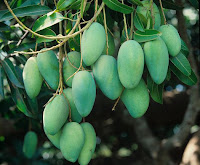The mango (Bangla- aam) is the king of fruits in
Bangladesh. It’s a fleshy stone fruit. Mango is generally very sweat and tasty common
fruits in Bangladesh. It’s also one of the most popular fruits in the world.
The mango is native to the Indian subcontinent from where it spread all over
the world. Generally, ripe mangoes have an orange-yellow or reddish peel and
are juicy for eating, and unripe with green peels.
The English word "mango" originated from the Tamil word ‘mangai’ or Malayalam ‘manna’. The word's first recorded attestation in a European language was a text by Ludovico di Varthema in Italian in 1510, as manga; the first recorded occurrences in languages such as French and post-classical Latin appear to be translations from this Italian text.
The largest number of mangos is produce in India, China, Thailand, Indonesia, Pakistan, Bangladesh, Mexico, Brazil etc.

Bangladesh produces a large number of superior varieties of mangos, mostly grown in Rajshahi, Nawabganj, and Dinajpur. These have wide demand in the market and are commercially important. Prominent among the elite varieties are Fazli, Langra, Ashini, Gopal-bogh, Laksman-bhog, Mohan-bhog, Raj-bhog, Himsagar, Chok anan, Khirsapat etc.
Bangladesh produces a large number of superior varieties of mangos, mostly grown in Rajshahi, Nawabganj, and Dinajpur. These have wide demand in the market and are commercially important. Prominent among the elite varieties are Fazli, Langra, Ashini, Gopal-bogh, Laksman-bhog, Mohan-bhog, Raj-bhog, Himsagar, Chok anan, Khirsapat etc.
Mango trees grow widely throughout Bangladesh and are raised mostly as homestead plantations. Mangoes of this country belong mainly to two groups, such as, (i) superior or the elite varieties which are propagated through grafting and other vegetative means; and (ii) local varieties, raised by seedlings, popularly known as 'Deshhi' or 'Guti am'. The latter has no recognized varietal names, and the taste is not assured.
The tree is evergreen and has a large, thick, and rough trunk; somewhat black bark, spreading branches; and a dense crown of foliage. When planted with wide spacing, the plant takes an umbrella-shaped top and may become more than 20 meter tall and 30 meter wide.
Mangoes are widely used in cuisine. Sour, unripe mangoes are used in chutneys, pickles, jam or side dishes, or may be eaten raw with salt green chili, sugar etc. Mango jelly made of mango pulp. Mangoes may be used to make juices, fruit bars, and as a flavoring and major ingredient in ice cream. Mango-milk is very popular dishes in Bangladesh.
The English word "mango" originated from the Tamil word ‘mangai’ or Malayalam ‘manna’. The word's first recorded attestation in a European language was a text by Ludovico di Varthema in Italian in 1510, as manga; the first recorded occurrences in languages such as French and post-classical Latin appear to be translations from this Italian text.
The largest number of mangos is produce in India, China, Thailand, Indonesia, Pakistan, Bangladesh, Mexico, Brazil etc.

Bangladesh produces a large number of superior varieties of mangos, mostly grown in Rajshahi, Nawabganj, and Dinajpur. These have wide demand in the market and are commercially important. Prominent among the elite varieties are Fazli, Langra, Ashini, Gopal-bogh, Laksman-bhog, Mohan-bhog, Raj-bhog, Himsagar, Chok anan, Khirsapat etc.
Bangladesh produces a large number of superior varieties of mangos, mostly grown in Rajshahi, Nawabganj, and Dinajpur. These have wide demand in the market and are commercially important. Prominent among the elite varieties are Fazli, Langra, Ashini, Gopal-bogh, Laksman-bhog, Mohan-bhog, Raj-bhog, Himsagar, Chok anan, Khirsapat etc.
Mango trees grow widely throughout Bangladesh and are raised mostly as homestead plantations. Mangoes of this country belong mainly to two groups, such as, (i) superior or the elite varieties which are propagated through grafting and other vegetative means; and (ii) local varieties, raised by seedlings, popularly known as 'Deshhi' or 'Guti am'. The latter has no recognized varietal names, and the taste is not assured.
The tree is evergreen and has a large, thick, and rough trunk; somewhat black bark, spreading branches; and a dense crown of foliage. When planted with wide spacing, the plant takes an umbrella-shaped top and may become more than 20 meter tall and 30 meter wide.
Mangoes are widely used in cuisine. Sour, unripe mangoes are used in chutneys, pickles, jam or side dishes, or may be eaten raw with salt green chili, sugar etc. Mango jelly made of mango pulp. Mangoes may be used to make juices, fruit bars, and as a flavoring and major ingredient in ice cream. Mango-milk is very popular dishes in Bangladesh.
Scientific Classification
|
|
| Kingdom |
Plantae |
| Division |
Angiospermae |
| Order |
Sapindales |
| Family |
Anacardiaceae |
| Genus |
Mangifera |
| Species |
M. Indica |
Binomial Name
|
|
Mangifera Indica
|
|





Mango Fruits Beautiful Images HD
ReplyDelete